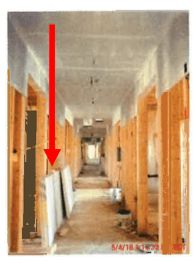Drywall Debacle on the Construction Site

,
Lt. Col. Bryan J. Smith, P.E., Construction Site Safety Expert
Case Description/Summary: During the construction of a senior care facility, a drywall subcontractor of the general contractor (GC), directed their material supplier when and where to place their drywall deliveries at the jobsite. The supplier made the specified deliveries throughout the jobsite as directed by their client. The supplier delivered the drywall vertically stacked, leaning against the bare wall studs in the corridors throughout the jobsite. Two workers from another subcontractor, a low voltage system installer, decided that they would tilt a stack of the drywall at one location, away from the supporting wall. They did this so they could install one of their card reader rough-in boxes on the open stud framing. While one of these workers “held” the pile of drywall away from the wall studs, the other went behind the upright drywall stack to install his box. While this was underway, the stack of drywall became too heavy for the worker holding it, and it collapsed onto the box installer – crushing his leg. The injured party filed suit against the GC, the property owner, the drywall subcontractor and the drywall supplier.

Expert Analysis: While the GC was held to be responsible for overall site safety by OSHA, they were not experts themselves in everything necessary to achieve safe material storage practices for specialty materials – such as drywall. However, the GC did not need to be proficient in all specific and/or unique safety principles and concepts on their own, in order to fulfill their obligations for overall site safety. The GC relied upon the expertise of their drywall subcontractor, who incorrectly believed that they were following industry common storage practices. The GC did not directly control the drywall subcontractor’s work means, manner or methods. Instead, the GC charged the drywall subcontractor to perform their scope of work under their own means, manner, and methods in the subcontract under which they hired the drywall subcontractor. This is a common construction industry practice and is widely used by general contractors such as this GC. To the extent that the GC didn’t know that the gypsum product manufacturers, as well as others, advised to never stack loose drywall sheets on edge, the GC wouldn’t be responsible to specifically understand that doing so was a safety hazard. This practice of the drywall subcontractor and drywall supplier was not seen by either party to be unusual or contrary to industry common practice. Even the GC’s 3rd party OSHA consultant witnessed this storage practice and believed that it exemplified “good housekeeping”. Neither the GC nor the property owner directed or instructed the drywall subcontractor or the drywall supplier to vertically stack drywall anywhere on the incident premises. The GC and the property owner relied upon the drywall subcontractor and/or their material supplier/deliverer to follow industry guidelines, in addition to all OSHA requirements. This included those which the GC was unaware, as well as any other requirements. OSHA did not specify any specific storage requirements for drywall. OSHA 1926.16(c) included the following statement: “…the subcontractor assumes responsibility with respect to his portion of the work” with regard to compliance with OSHA rules. OSHA 1926.250(a)(1) said that “All materials stored in tiers shall be stacked, racked, blocked, interlocked, or otherwise secured to prevent sliding, falling or collapse.”
OSHA’s letter of interpretation addressed competent persons at construction sites and said in part: “…the general contractor normally has responsibility to assure that the other contractors fulfill their obligations with respect to employee safety which affect the entire site. The general contractor is well situated to obtain abatement of hazards, either through its own resources or through its supervisory role with respect to other contractors. It is therefore reasonable to expect the general contractor to assure compliance with the standards insofar as all employees on the site are affected.” This letter of interpretation went on to say: “On the other hand, the Occupational Safety and Health Review Commission also noted in that decision that the duty imposed on a general contractor is a reasonable one and that a general contractor will not be held liable “for violations which it could not reasonably be expected to detect or prevent.” Another section of this letter said: “When an employer contracts with a specialist, the employer is justified in relying upon the specialist to protect against hazards related to the specialist’s expertise, as long as the reliance is reasonable, and the employer has no reason to foresee that the work will be performed unsafely”. And: “We would expect general contractors to take the steps necessary to satisfy themselves that subcontractors engaged in activities which call for the involvement of competent persons will fulfill that obligation as well as the general inspection obligations.” The GC accomplished all these responsibilities, therefore their reliance on the drywall subcontractor’s and supplier’s OSHA compliance was not unreasonable. A review of OSHA’s Multi-Employer Citation Policy was included in the evaluation. Both the drywall subcontractor and supplier, plus the low voltage subcontractor violated OSHA requirements. Additionally, had the plaintiff complied with industry edicts as well as his own company’s safety manual, both of which forbade him from touching another trade’s materials – such as the drywall involved in this incident – his incident would not have occurred. The plaintiff even admitted that he could have performed his work without even moving the 1,500 pounds of vertically stacked drywall.
Result: The plaintiff settled out of court for a minor amount.
Lt. Col. Bryan J. Smith, P.E., Construction Site Safety Expert with DJS Associates, Inc., can be reached via email at experts@forensicDJS.com or via phone at 215-659-2010.


